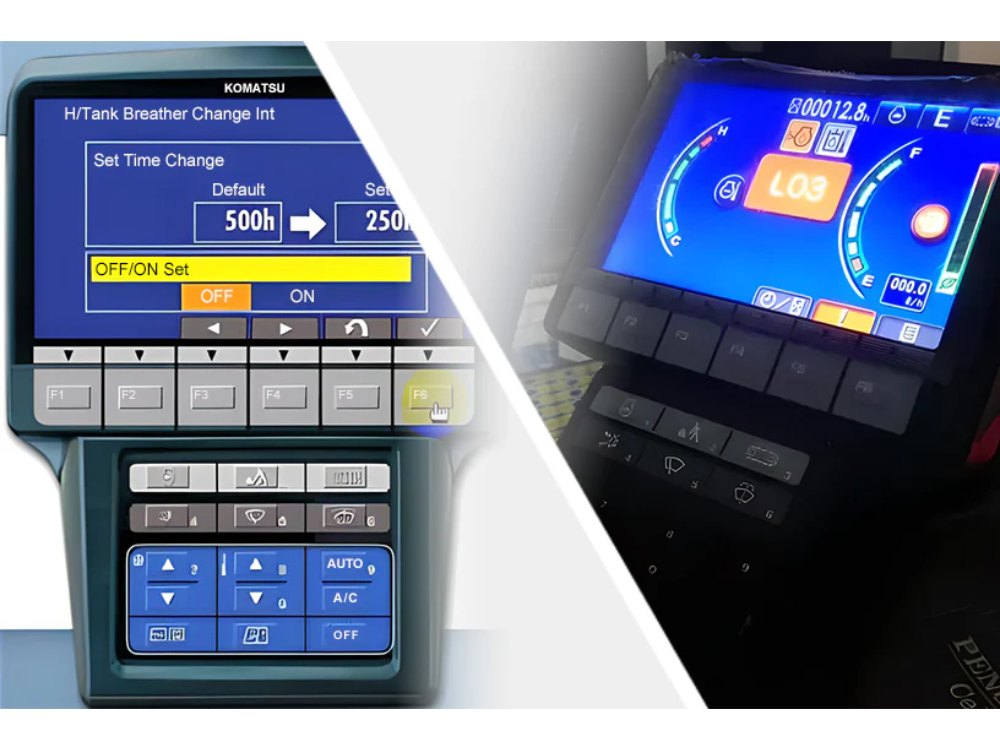Recommend Products
-
$25,600$27,000
-
$28,000$31,000
-
$22,000$27,000
-
$26,000$29,000
Today, TD will briefly introduce the identification of common fault codes and daily maintenance methods to users of Komatsu excavators. Usually, during the use of excavators, the equipment will give users tips and suggestions to a certain extent, but the development of faults, especially the occurrence of some sensor prompts When certain faults occur, users need to have a certain basis for identifying fault codes. Of course, some minor faults and prompts usually do not hinder the normal use of the equipment. However, once a core fault occurs and an alarm occurs, the driver must immediately shut down for inspection and maintenance, and troubleshoot and solve the problem to avoid causing great damage to the equipment and causing losses to the user.

1. E001: Engine oil pressure is too low. Solution: Check the engine oil level and oil filter.
2. E002: The engine water temperature is too high. Solution: Check the cooling system and coolant.
3. E003: Hydraulic oil temperature is too high. Solution: Check the hydraulic system and radiator.
4. E004: Oil-water separator failure. Solution: Check whether the oil-water separator needs to be replaced.
5. E005: Engine overspeed. Solution: Check the throttle control system.
6. E006: The engine is short of coolant. Solution: Add enough coolant.
7. E007: The hydraulic system pressure is too high. Solution: Check the pressure regulating valve of the hydraulic system.
8. E008: The hydraulic system pressure is too low. Solution: Check the hydraulic pump and hydraulic oil.
9. E009: Engine sensor failure. Solution: Check the sensor connections and wiring.
10. E010: Engine oil temperature sensor failure. Solution: Check the sensor connections and wiring.
11. E011: Steering system failure. Solution: Check the steering pump and steering valve.
12. E012: Braking system failure. Solution: Check the brake fluid and brake pads.
13. E013: Electrical system failure. Solution: Check the battery and generator.
14. E014: Oil pressure sensor failure. Solution: Check the sensor connections and wiring.
15. E015: Engine water temperature sensor failure. Solution: Check the sensor connections and wiring.
16. E016: Hydraulic oil pressure sensor failure. Solution: Check the sensor connections and wiring.
17. E017: Engine control unit failure. Solution: Check the connections and wiring of the control unit.
18. E018: Hydraulic pump failure. Solution: Check the operation and connections of the hydraulic pump.
19. E019: Air intake system failure. Solution: Check the intake pipe and air filter.
20. E020: Engine fuel pressure sensor failure. Solution: Check the sensor connections and wiring.
21. E021: Fuel injector failure. Solution: Check whether the fuel injector is clogged.
22. E022: Cylinder pressure sensor failure. Solution: Check the sensor connections and wiring.
23. E023: Engine throttle failure. Solution: Check the throttle connections and wiring.
24. E024: Engine exhaust temperature sensor failure. Solution: Check the sensor connections and wiring.
25. E025: Tire pressure sensor failure. Solution: Check the sensor connections and wiring.
26. E026: Brake failure. Solution: Check the brake connections and wiring.
27. E027: Steering shaft failure. Solution: Check the steering shaft connection and wiring.
28. E028: The fuel filter is clogged. Solution: Clean or replace the fuel filter.
29. E029: The air filter is clogged. Solution: Clean or replace the air filter.
30. E030: The engine is short of fuel. Solution: Add enough fuel.
31. E031: There is water in the hydraulic oil. Solution: Change the hydraulic oil.
32. E032: The engine is short of air. Solution: Check the intake pipe and air filter.
33. E033: Engine intake air temperature sensor failure. Solution: Check the sensor connections and wiring.
34. E034: Engine oil level is low. Solution: Add enough engine oil.
35. E035: Engine lacks cooling water. Solution: Add enough cooling water.
36. E036: Steering oil level is low. Solution: Add enough steering oil.
37. E037: Brake oil level is low. Solution: Add enough brake fluid.
38. E038: There is air in the steering system. Solution: Exhaust air in the steering system.
39. E039: There is air in the braking system. Solution: Exhaust air from the brake system.
40. E040: Engine intake pressure sensor failure. Solution: Check the sensor connections and wiring.
41. E041: Fuel injector controller failure. Solution: Check the controller connections and wiring.
42. E042: Air filter sensor failure. Solution: Check the sensor connections and wiring.
43. E043: Oil-water separator sensor failure. Solution: Check the sensor connections and wiring.
44. E044: Engine radiator failure. Solution: Clean or replace the engine radiator.
45. E045: Engine fan failure. Solution: Check the fan connections and wiring.
46. E046: Engine throttle position sensor failure. Solution: Check the sensor connections and wiring.
47. E047: The fuel injector is clogged. Solution: Clean or replace the fuel injector.
48. E048: Engine ignition system failure. Solution: Check the ignition coil and spark plug.
49. E049: Hydraulic pump controller failure. Solution: Check the controller connections and wiring.
50. E050: The engine is short of oil. Solution: Add enough engine oil.
For example, the reminder of a fault code is not necessarily an equipment failure. Some used excavator sensors also have certain false alarms or sensor damage in long-term working environments, daily use and differential temperature differences. We need to identify them when using them. For technology Very skilled excavator users can easily identify them, but beginners must remember a few core fault codes.